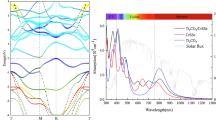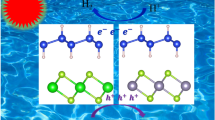Abstract
Semiconductor photocatalysts are hampered by carriers' recombination problems that hinder their practical application. The rational design of direct Z-scheme heterojunctions based on two-dimensional (2D) materials is one of the effective ways to solve this problem. Therefore, we predicted 2D CrS2/boron phosphide (BP) van der Waals heterojunction as a potential direct Z-scheme photocatalyst based on density functional theory. The CrS2/BP heterojunction has a small direct band gap, which is favorable for light absorption. In addition, the built-in electric field promotes the separation and transfer of the desired carriers. Photogenerated electrons and holes are localized in the conduction band of the BP component and the valence band of the CrS2 component, respectively. In addition, it was found that the heterojunction obtained a relatively small band gap and a wide optical absorption range at + 4% and + 5% strains. Therefore, the CrS2/BP heterojunction is a new photocatalyst satisfying the direct Z-scheme charge transfer mechanism, which has a certain application value.
Graphical Abstract











Similar content being viewed by others
References
Cheng L, Xiang Q, Liao Y, Zhang H (2018) Energy Environ Sci 11:1362–1391
Kim JH, Hansora D, Sharma P, Jang J-W, Lee JS (2019) Chem Soc Rev 48:1908–1971
Walter MG, Warren EL, McKone JR, Boettcher SW, Mi Q, Santori EA, Lewis NS (2010) Chem Rev 110:6446–6473
Chen X, Shen S, Guo L, Mao SS (2010) Chem Rev 110:6503–6570
Chen X, Li C, Grätzel M, Kostecki R, Mao SS (2012) Chem Soc Rev 41:7909–7937
Khan I, Qurashi A, Berdiyorov G, Iqbal N, Fuji K, Yamani ZH (2018) Nano Energy 44:23–33
Faraji M, Yousefi M, Yousefzadeh S, Zirak M, Naseri N, Jeon TH, Choi W, Moshfegh AZ (2019) Energy Environ Sci 12:59–95
O’regan B, Grätzel M (1991) Nature 353:737–740
Su T, Shao Q, Qin Z, Guo Z, Wu Z (2018) ACS Catal 8:2253–2276
Fu C-F, Wu X, Yang J (2022) Chem Phys Rev 3:011310
Ma Y, Wang X, Jia Y, Chen X, Han H, Li C (2014) Chem Rev 114:9987–10043
Yousefpour P, McDaniel JR, Prasad V, Ahn L, Li X, Subrahmanyan R, Weitzhandler I, Suter S, Chilkoti A (2018) Nano Lett 18:7784–7793
Luo B, Liu G, Wang L (2016) Nanoscale 13:86904–86920
Novoselov KS, Geim AK, Morozov SV, Jiang D-E, Zhang Y, Dubonos SV, Grigorieva IV, Firsov AA (2004) Science 306:666–669
Meng J, Wang J, Wang J, Li Q, Yang J (2022) J Mater Chem A 10:3443–3453
Li ZZ, Meng XC, Zhang ZS (2018) J Photochem Photobiol C 35:39–55
Kwag SH, Lee YS, Lee J, Jeong DI, Kwon SB, Yoo JH, Woo S, Lim BS, Park WK, Kim MJ, Kim JH, Lim B, Kang BK, Yang WS, Yoon DH (2019) ACS Appl Energy Mater 2:8502–8510
Herbig C, Michely T (2016) 2D Mater 3:025032
Huo L, Liu B, Gao Z, Zhang J (2017) J Mater Chem A 35:18494–18501
Ren K, Tang W, Sun M, Cai Y, Cheng Y, Zhang G (2020) Nanoscale 12:17281–17289
Zhang W, Ji W (2020) Phys Chem Chem Phys 22:24662–24668
Yu J, Wang S, Low J, Xiao W (2013) Phys Chem Chem Phys 15:16883–16890
Kresse G, Furthmüller J (1996) Phys Rev B 54:11169
Perdew JP, Burke K, Ernzerhof M (1996) Phys Rev Lett 77:3865
Liu B, Wang X, Xu J-L, Tian D, Chen R-Y, Xu J, Buab X-H (1994) Phys Rev B 49:16223–16233
Grimme S (2006) J Comput Chem 27:1787–1799
Heyd J, Scuseria GE, Ernzerhof M (2003) J Chem Phys 118:8207–8215
Wang V, Xu N, Liu J-C, Tang G, Geng W-T (2021) Comput Phys Commun 267:108033
Wang Q, Domen K (2019) Chem Rev 120:919–985
Do T-N, Idrees M, Binh NT, Phuc HV, Hieu NN, Hoa LT, Amin B, Van H (2020) RSC Adv 10:44545–44550
Zhao P, Liang Y, Ma Y, Huang B, Dai Y (2019) J Phys Chem C 123:4186–4192
Wang Z, Lin Z, Shen S, Zhong W, Cao S (2021) Chin J Catal 42:710–730
Cao J, Zhang X, Zhao S, Wang S, Cui J (2022) Appl Surf Sci 599:154012
Jiang Q, Zhang J, Huang H, Wu Y, Ao Z (2019) J Phys Chem C 123:11591–11601
Wu W, Ao Z, Yang C, Li S, Wang G, Li C (2015) J Mater Chem C 3:2593–2602
Fu CF, Wu X, Yang J (2018) Adv Mater 30:1802106
Funding
Funding was provided by the Technology Coordination Innovation Project of Shaanxi province (Grant No.: S2018-ZC-PT-0024)
Author information
Authors and Affiliations
Contributions
SZ: Writing—original draft, Conceptualization, Methodology, Investigation, Software, Writing—review & editing. XZ: Conceptualization, Resources, Supervision. JC: Investigation, Methodology, Software, Formal analysis.
Corresponding author
Ethics declarations
Conflict of interest
The authors declare no competing financial interest.
Additional information
Publisher's Note
Springer Nature remains neutral with regard to jurisdictional claims in published maps and institutional affiliations.
Rights and permissions
Springer Nature or its licensor (e.g. a society or other partner) holds exclusive rights to this article under a publishing agreement with the author(s) or other rightsholder(s); author self-archiving of the accepted manuscript version of this article is solely governed by the terms of such publishing agreement and applicable law.
About this article
Cite this article
Zhao, S., Zhang, X. & Cao, J. Mechanistic Study of CrS2/BP as a Direct Z-Scheme Heterojunction for Photocatalyst of Splitting Water Under Biaxial Strain. Catal Lett 154, 60–70 (2024). https://doi.org/10.1007/s10562-022-04224-8
Received:
Accepted:
Published:
Issue Date:
DOI: https://doi.org/10.1007/s10562-022-04224-8




